Performance of EPA Method 8270 using Hydrogen Carrier Gas on SCION GC-MS
Introduction
United States Environmental Protection Agency (USEPA) Method 8270 is an analytical method for the detection of semi-volatile organic compounds in solid waste matrices, soils, air sampling media and water samples, by gas chromatography with mass spectrometry (GC-MS). The method measures a mixture of acids, bases and neutrals in sample extracts. The complexity of these extracts demand a robust instrument that is easy to operate and maintain. Adding to method complexity is the uncertainty in both cost and supply of helium, forcing laboratories to consider hydrogen as a carrier gas. Hydrogen is not an inert gas; it is reactive and can be an explosion hazard if allowed to build up in the GC oven or manifold of the MS.
The SCION helium free analyser will ensure safe routine operation, with no performance change when operating under EPA Method 8270 specifications. SCION’s unique axial ion source provides excellent robust operation and minimises unwanted protonation and spectral distortions. In addition, the GC with split/splitless (SSL) injector and inert pathway prevent compound degradation and reactions with the hydrogen carrier gas. This application note demonstrates the exceptional performance of the SCION GC-MS when operated under Method 8270 specifications.
Experimental
Table 1 details the operating parameters used throughout this application note. Please note, when using hydrogen carrier gas for the first time, more hydrocarbon background will be observed, but this will reduce with operation. The initial background can be reduced significantly by increasing the ion source temperature to 350°C, hydrogen column flow at 4mL/min and filament turned on for four hours.
Calibration standards containing 76 target compounds were used. The calibration ranged from 1ppm to 200ppm for the majority of compounds. Internal and surrogate standards were added at a concentration of 40ppm, in dichloromethane.
A pulsed split injection was used to minimise contact and residence time of compounds in the inlet. This is critical in hydrogen carrier gas due to its low viscosity and tendency to react with dichloromethane and form HCL.
The single goose-neck 4mm open inlet liner is preferred with Method 8270. As the liner does not contain glass wool, compound degradation is eliminated especially when using hydrogen as a carrier gas, due to its reactive properties.
Table 1. Analytical conditions of the GC-MS
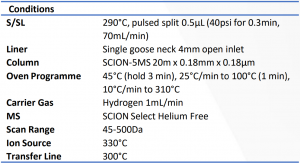
Results
In order for hydrogen to be used as a carrier gas, the specifications of Method 8270 must be met. These specifications include tuning of the instrument, resolution, calibration, peak shape (Gaussian Factor) and system performance checks (SPCCs). Additionally, dichloromethane must be used as solvent to minimise degradation in the inlet. The GC-MS system must also produce mass spectra that match the NIST library and demonstrates robust operation when heavy matrices are analysed.
The SCION analyser can be auto-tuned with a tune-totarget feature for decafluorotriphenylphosphine (DFTPP) , as required by the EPA method. Figure 1 shows the spectra for DFTPP acquired during the tune report. The set criteria for the DFTPP tune can be found in table 2. All requirements were met and the tune passed inspection. The DFTPP concentration was
50µg/mL with a 1µL injection.
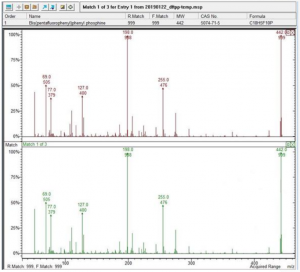
Figure 1. Mass spectra of DFTPP
Table 2. Tune acceptance criteria and true values
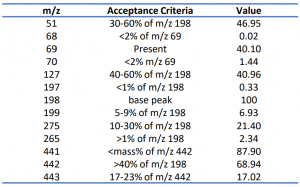
Once the system has been tuned, a calibration series was analysed. EPA Method 8270 implements a calibration range of 0.5ppm to 160ppm, however, at the request of a laboratory that require EPA Method 8270 at a level from 0.075ppm to 30ppm, a calibration at this range was also analysed. These low concentrations show the excellent capability of the system to detect the compounds lower than those tested by EPA. As recommended by the method, internal standards were used at a concentration of 40ppm. The SCION SQ Mass Spectrometry software has a unique feature, Compound Based Scanning (CBS), in which SIM ions for compounds are stored in a library. The scan information, compound retention times and individual dwell times are all stored and are easily selected and loaded directly into a data acquisition method allowing both simultaneous mixed scan mode.
Table 3 details the retention times and SIM ions used throughout this application.
Table 3. Retention time and SIM Ions of method compounds
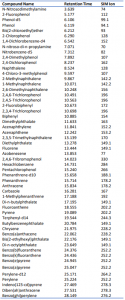
The calibration data, comprising of correlation coefficient, relative response factor and relative standard deviation, for calibration check compounds (CCC), as specified in Method 8270, can be found in Table 4. All quality control and system performance check samples passed the method requirements.
Table 4. Calibration data for SPCCs and CCCs
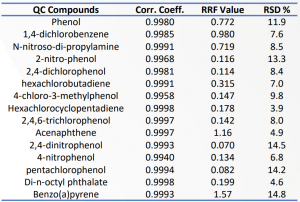
A biodiesel sample containing all 76 of the specified compounds were ran. The overall RSD% was 8.5%. The calibration curves of hexachlorocyclopentadiene, a system performance check compound, and pyridine, a EPA specified compound, can be seen in Figures 2 and 3.
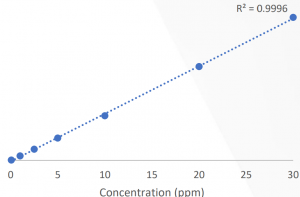
Figure 2. Calibration curve of hexachlorocyclopentadience
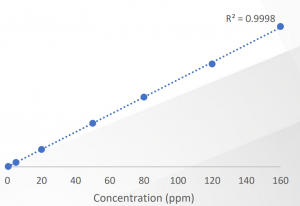
Figure 3. Calibration curve of pyridine
Figure 4 shows the calibration response factors for nine active compounds analysed. All response factors were less than 10% showing minimal reactivity when hydrogen is used as a carrier gas and dichloromethane as a solvent.
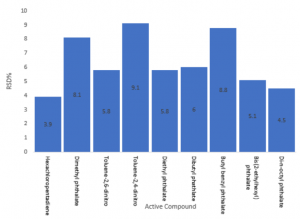
Figure 4. Calibration response factors of active compounds
When using hydrogen as a carrier gas, spectral quality can be compromised due to unwanted protonation or other reactions in the ion source. However, the SCION axial ion source, helium free package, minimises these reactions allowing good quality library matches to NIST. During this study, all seventy six compounds were detected using automated library search against NIST. Figure 5 illustrates an example library match for 1,2,4-trichlorobenzene with a match of over 96%.
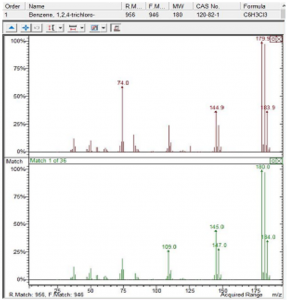
Figure 5. Spectra match of 1,2,4-trichlorobenzene
EPA Method 8270 performance was tested using repeated injections of a contaminated sludge extract. A total of fifty injections were made, with the injection of the continuing calibration check (CCC) after every ten injections. The calculated concentration of the surrogates (target 40ppm) and the % recoveries in responses of the compounds were compared to the initial injection. Figure 6 shows the percent differences observed for the CCs.
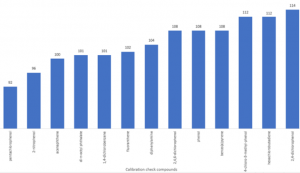
Figure 6. recovery % of calibration check compounds
The observed differences in concentrations throughout the fifty injections were considerably low. This demonstrates that the SCION SQ mass spectrometer is a robust instrument even when hydrogen is the carrier gas of choice.
Figure 7 shows the recovery of a surrogate standard over ten injections. The observed concentrations and % difference of a 40ppm 2,4,6-tribromophenol surrogate are also detailed.
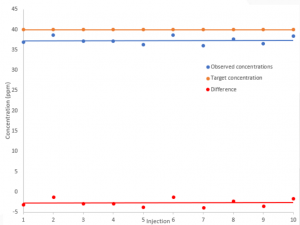
Figure 7. Target and observed concentrations with % difference of 2,4,6-
tribromophenol.
Conclusion
EPA method 8270 is a challenging method covering a wide variety of compound classes and matrix types. As the cost and scarcity of helium rises, laboratories seek to amend methods to the use of hydrogen carrier gas. Due to its reactivity, hydrogen must be able to safely be used during GC-MS operation.
The SCION SQ has demonstrated excellent performance for method 8270, ensuring all qualitative and quantitative aspects of the method pass, and exceed, specification, when hydrogen is used a carrier gas. The axial ion source and pulsed split injection technique, of the SSL injector, produced excellent library searchable mass spectra whilst also passing quality control criteria, even in heavy matrices. Additionally, the robustness of the ion source and sensitivity of the instrument allow lower reporting limits in challenging sample extracts, thus eliminating the challenges associated with EPA method 8270.
Download The Application Note
Download a PDF version using the following link: Performance of EPA Method 8270 using Hydrogen Carrier Gas on SCION GC-MS
